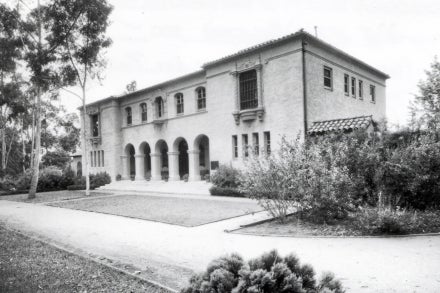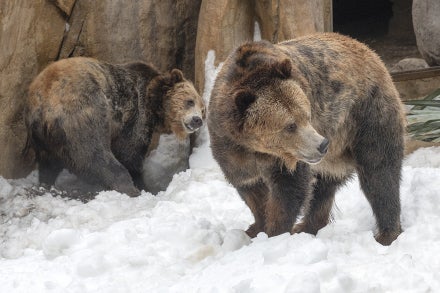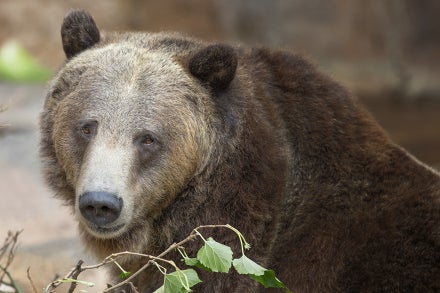
Walking under the shade of towering thorn trees, you crest a hill and see a rhino lounging near an oasis dotted with slender palms and robust fig trees. A gentle breeze rustles through the canopy, carrying the sweet scent of blooming gardenias. The rhino lazily rises, tempted by a nearby acacia branch that looks too delicious to resist. Now, imagine this same scene—without the trees. Pretty different, right? Trees do more than simply beautify the landscape; they are essential pillars that provide habitat, food, and shelter while contributing to a vibrant, biodiverse environment.
Cultivating Excellence
The San Diego Zoo and San Diego Zoo Safari Park have a long history of cultivating trees and plants that are authentic to the natural habitats of our wildlife. Whether we’re bringing the African savanna to life for the new Denny Sanford Elephant Valley or creating a lush Asian forest canopy at the Zoo—with towering ficus trees and their dangling aerial roots—trees help us immerse visitors in new, exciting environments. What you might not know is how deeply involved San Diego Zoo Wildlife Alliance is in global tree conservation. While the Zoo and Safari Park are well-known for unparalleled work with threatened animal species, our robust work with tree conservation and research is less well-known. San Diego Zoo Wildlife Alliance recently earned accreditation as an official arboretum through the Arboretum Accreditation Program, highlighting our commitment to tree conservation. It’s just another way we’re branching out to protect the planet.
Managed by the internationally renowned Morton Arboretum, the program has several levels of accreditation, and the level achieved by San Diego Zoo Wildlife Alliance (Level IV) is both the highest and most complex. Level IV accreditation highlights the care and energy that we put into managing our landscape, as well as our ongoing commitment to tree-related education, scientific research, collection diversity, and meticulous recordkeeping. Interdisciplinary collaboration between the Zoo, Safari Park, and Conservation Science teams dynamically leverages decades of experience caring for rare and endangered plants to effectively conserve wild tree populations worldwide.


Torrey pines are the rarest pine species in North America, found only along the central coast of San Diego County and on Santa Rosa Island, 173 miles off Santa Barbara.
Great Oaks from Little Acorns Grow
San Diego Zoo Wildlife Alliance’s work with California oak species is a perfect example of this collaboration. Through Botanic Gardens Conservation International (BGCI), our staff act as regional conservation coordinators for several oak species that are endemic to California—all of which are threatened in their native environment. This involves working with regional partners to coordinate and communicate conservation work and conservation needs. Our team also engages in in situ conservation work with oak populations throughout San Diego County and beyond—often in Baja California and the Channel Islands, where these oaks have incredibly restricted and sensitive populations. Through the collection of acorns, we can propagate new oak seedlings to help replenish and safeguard these populations. These oaks can be planted at either the Zoo or the Safari Park’s Biodiversity Reserve as meta-collection populations, or be shared with local habitat restoration efforts.
We also collect living tissue from the trees themselves and push cutting-edge research through grant-funded science for alternative conservation strategies such as micropropagation and cryopreservation. Through micropropagation we can grow living oak tissue in the lab and hold a grove of endangered trees in the palm of our hand. And with cryopreservation, the same technology that supports San Diego Zoo Wildlife Alliance’s Frozen Zoo® now can also be applied to plants. As this research moves forward, it will help preserve genetic material for generations of conservation work to come.
Between Every Two Pines Isa Doorway to Another World
Del Mar and La Jolla, California, are famous for their stunning beaches and the iconic Torrey pines that tower above the rugged sandstone bluffs. These majestic trees are the rarest pine species in North America, found only along the central coast of San Diego County and on Santa Rosa Island, 173 miles off Santa Barbara. Sadly, drought and bark beetle outbreaks are threatening the last native Torrey pines on mainland California, and challenges to environmental sustainability are only making things worse.
For decades, the Zoo and Safari Park have been leaders in Torrey pine conservation. Our team has been carefully growing and studying Torrey pines to support ongoing conservation efforts. For over 50 years, our horticulturists and arborists have honed their skills to help these trees thrive from seed to maturity. Safari Park arborists, working alongside Plant Conservation scientists, collect germplasm samples from Torrey Pines State Natural Reserve, contributing to vital genetic research. By studying both the ex situ trees at the Safari Park and native Torreys, we’re working to understand how to protect and manage Torrey pines. This research will help ensure the long-term survival of this unique species.


(Above, top) San Diego Zoo horticulturists Dario Berrini and Greg Bluffin collect acorns for propagation. An Eastern Cape giant cycad cone.
Guardians of the Cycads: Protecting the Plants That Outlived the Dinosaurs
Cycads are some of the planet’s oldest survivors—ancient seed plants that have stood the test of time, outliving the dinosaurs and surviving three mass extinctions over millions of years. But today these remarkable plants face an uncertain future. Caught in the crosshairs of wildlife trafficking, habitat loss, and challenges to environmental sustainability, many cycad species are now among the most threatened plants on Earth, with some teetering on the edge of extinction due to human impact.
San Diego Zoo Wildlife Alliance is stepping up to protect these living fossils. With extensive cycad collections at both the Zoo and Safari Park, we’re using our horticultural expertise and global partnerships to ensure the survival of these ancient plants. As part of the Global Conservation Consortium for Cycads, San Diego Zoo Wildlife Alliance is leading efforts to save cycad species from disappearing forever. One exciting development is our newly created Cycad Species Stewardship Garden at the Safari Park, which focuses on South Africa’s rare Encephalartos species. Located along the Africa Tram, this garden not only showcases these incredible plants, but also supports critical propagation efforts and offers a chance to share the story of cycad conservation with visitors.
We’re also funding research on native cycad populations in South Africa, collaborating with organizations like Botanic Gardens Conservation International and the Wild Cycad Conservancy. Together,our goal is clear: ensure that no wild cycad species becomes extinct. Through education, conservation, and collaboration, San Diego Zoo Wildlife Alliance is helping secure a future for these ancient plants that have already defied the odds for millions of years.
Beyond San Diego
This is just the beginning of our tree and plant conservation efforts! Through projects like the Native Seed Bank at the Safari Park and our work in places like Palau, Hawai'i, South Africa, and beyond, we’re making a real difference in protecting trees and plants worldwide. If you’d like to know more about all our plant conservation efforts, please consider visiting the Zoo during the third Friday of every month for our Plant Day event. The Safari Park now offers a Botanical Tram tour on Saturdays and Sundays at noon, where guests can enjoy a unique, plant-focused tour that highlights plant conservation and zoological horticulture. The seeds we plant today—both horticultural and educational—will help propagate a brighter future for all.




